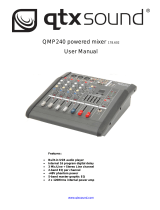
16, 22, 22MTK User Manual
3.1: INTRO TO I/O
INPUTS & OUTPUTS > INTRODUCTION TO I/O
3.1: INTRODUCTION TO I/O
The Signature console offers a choice of industry standard audio inputs and outputs. All Jack and XLR
inputs are balanced. Below are some terms used in this manual and on the console labelling that may
be of use to you.
AUX (Auxiliary) Output
An output bus made up of the summed Aux
contributions from input channels. In other
words, the AUX1 output will be a mix of all input
channel signals, with levels controlled by the
AUX1 controls on the individual input channels.
Auxiliary mixes are used for many purposes -
alternative mixes for monitoring, processing by
external FX units, and more.
Balanced
A ‘Balanced’ signal (Balanced Line) is one where
the signal is split between two conductors with
the same impedance / impedance to ground.
At a differential input, the differences between
thetwoconductorsareamplied,soanynoise
acquired between output and input is rejected
(common-mode rejection).
GRP (Group)
An output bus made up of the summed contri-
butions from any inputs routed to the Group. For
example, all inputs with their 1-2 buttons pressed
will be added to the GRP1 and GRP2 mixes. The
pan / balance control determines how the signal
is proportioned between the Group 1 and Group
2 busses (Group 1 left, and Group 2 right).
Hi-Z
High Impedance. Guitar pick-ups generally have
‘high impedance’ outputs and therefore require
asignicantlyhigherthanusualinputimped-
ance when plugging them directly into a console
(straight from the guitar plug - not via an amp
or a microphone). Hi-Z Inputs provide this. On
the Signature console selected inputs have Hi-Z
input switches to accommodate Hi-Z sources.
Jack
This is the long, quarter-inch connection most
commonly used on the signature console for
line level inputs and outputs such as keyboards,
external FX processors, playback and recording
devices, and so on. All Signature-series Jack
sockets are ‘Tip-Ring-Sleeve’ 3-pole types. Jack
outputs are impedance balanced.
Line
For inputs and outputs this refers to a line level
signal. This is a higher voltage signal than ‘mic
level’.
Mic
Microphone. For inputs and outputs this refers to
a mic level input. This is a lower voltage signal
than ‘line level’.
MST (Master)
Master Stereo Output: The main stereo Group
output made up of the summed contributions
from any inputs routed to ‘MST’ with their ‘MST’
buttons.
RCA
The small line-level connector commonly found
on consumer playback equipment. RCA inputs
are provided for the 15/16 (Signature 16) and
21/22 (Signature 22 / 22MTK) stereo input
channels (Playback Channels).
USB - Universal Serial Bus
Standard serial data connection used by the
Signature console for sending and receiving
digital audio streams.
XLR
The round, three-pin connections. On the
Signature console they are used for microphone
inputs and the main stereo outputs.






















